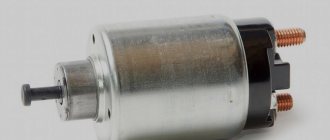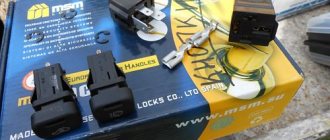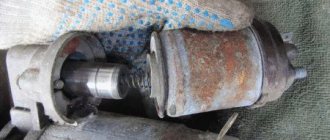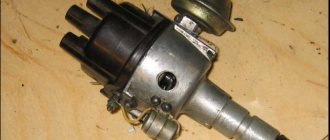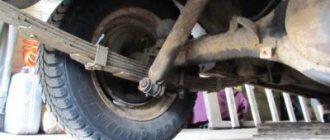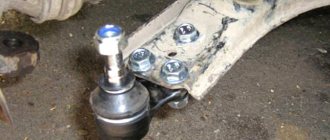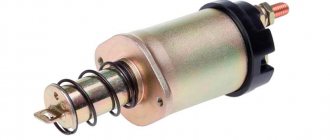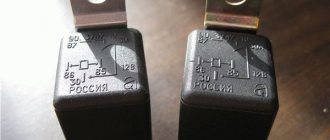Solenoid relay design and operating principle
In the starter, the solenoid relay engages the flywheel crown with the bendix. All work is based on the principles of electromagnetism. The core, which is made as a hollow tube, inside which the armature is located, is equipped with a wire winding. The current in the coil creates an electromagnetic field, as a result of which the armature enters the core. After the current stops flowing, the armature can move freely.
The starter retractor relay includes: housing; magnet with windings; anchor; contacts; return spring. The magnet in the relay is made in the form of a pair of coils - retracting and holding. The relay retractor coil is connected to the electric motor and the control terminal, but the holding coil is connected to the control terminal and is in contact with the housing. When power is applied to the control contact, magnetic induction occurs in the coil, which leads to the appearance of a magnetic field. As a result, the armature compresses the return spring. At the same moment, the bendix rotates, which connects the starter to the car battery. At the time when the contacts close, the retractor winding receives power from the “+” terminal, the production of current in the coil stops, but the armature is affected by the field of the holding coil, so it remains inside. When the vehicle's power unit starts, the power is cut off, causing the armature to return to its original position under the action of the return spring. The contacts open, which can cause the bendix to disengage.
A little theory
In general, modern starters are equipped with a pair of relays. The first is responsible for turning on the unit. It is located directly in the engine compartment, and in some car models the relay is also placed in a separate housing. The second relay, called traction ( retractor ), is installed directly on the starter. This device has several functions:
- Ensuring synchronous operation of automobile starter components when starting the internal combustion engine;
- Electrical distribution energy between the electromagnetic relay and the starter motor;
- Ensuring the joint operation of the overrunning clutch and the flywheel ring (supply of gears) and, conversely, withdrawal of gears at the right time.
Here's how it all works: when the contacts in the ignition switch are closed, the usual starter relay is immediately activated, which is responsible for supplying voltage from the battery to the so-called. pull-in winding. As a result, a magnetic field is induced, acting on the relay armature, due to which it gets inside the winding. Now 2 actions are carried out at once: the starter fork begins to move, helping the overrunning clutch, also called the bendix, to move, and the contacts of the installed retractor relay close. Simply put: the starter is now connected to the flywheel, after which it is connected to the battery and by passing current through the circuit, the engine can now start. Do not forget that the operation of combustion systems without proper operation of the electrical circuits of the car is impossible.
However, this is not all. Now, when the starter turns on, due to the operation of the so-called. holding coil, the armature is held in its extreme position - in this mode of operation, the solenoid relay does not consume much energy. And if the engine is already running, the starter circuit is broken and the relay is de-energized. Automotive relays have a spring - it is this spring that, trying to compress, returns the armature to its initial position. Then the contact disk and bendix change their position. The battery turns off. Then the relay is no longer involved in the operation of the car until the engine is started.
Signs of a malfunctioning retractor
The following signs may indicate a retractor failure:
- After starting the engine, the starter does not turn off; it rotates at high speed and has a characteristic buzzing sound.
- After turning the key in the ignition switch, a click occurs, indicating that the device is activated, but no rotation of the starter is observed. Sometimes, if there is a break in the coil, the armature is stuck in a certain position, or there is no power, there may be no click.
- After turning the key in the lock, the starter begins to idle without affecting the engine flywheel.
Signs and causes of relay failure
The very first symptom of a broken traction relay is the inability to start the engine. In this case, strange sounds may be heard coming from the trigger mechanism. You don't need to be a professional mechanic to identify a broken starter. When you turn the key, the car will either not start, or it will take several attempts. Sometimes it happens that the engine is already running, the key is released, but the Bendix wheel does not disconnect from the ring gear.
There are not so many reasons for traction failures. Two of them are mechanical - the Bendix return spring is broken or the overrunning clutch is jammed. In the first case, the gear will not engage well or will not detach from the ring gear. In the second, the pull-in winding does not have enough power to overcome such resistance. As a result, neither the motor turns nor the bendix extends.

